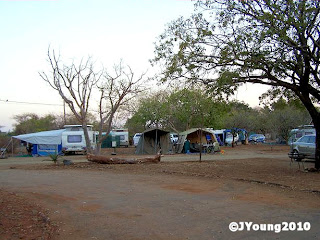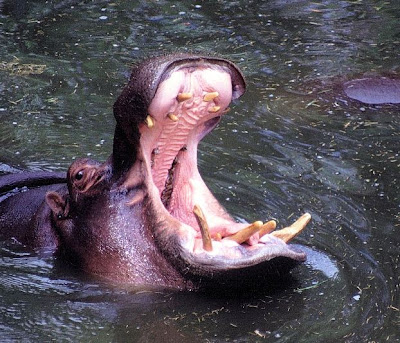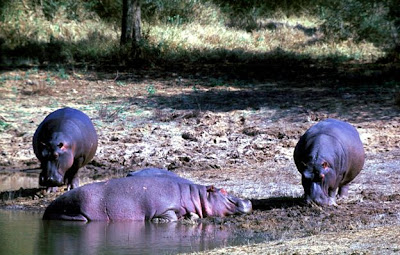I thought I would add a bit on the accommodation and amenities in the park for those who are interested.
The park caters for all kinds of people and has accommodation to suit all pockets. Most of the camps are built on the bank of rivers and so you have a constant view of animals coming down to drink water. They have left the vegetation in place so most of the trees are very old.

There are various types of chalets, some have a kitchen and some not although each has their own bathroom and whether it has a kitchen or not, each has a refrigerator. All have linen and blankets on the beds plus towels. They vary in size from 2 - 4 beds. Larger ones cater for families with a separate kitchen, diningroom, lounge and 2-3 bedrooms. THERE ARE NO TV’s or RADIOS in any, with an extremely strict rule of no noise after 10pm. Those with kitchens are fully quipped with cutlery, plates, pans, pots, kettle etc.

Each chalet is airconditioned and also has its own barbeque area with chairs and tables outside. Cleaning staff come in every day to keep it immaculate.

Some of the camps have them decorated in true African colors and designs. All the windows and door have mosquito netting on them.

Each camp has a wonderful camping area where you can put up your own tent or camper. Each site has once again, it’s own barbeque facility.

In the camping areas, there are spotlessly clean communal bathrooms with toilets, showers, basins and baths.

The kitchens have hot and cold water, washing up basins and a small two plate stove in case you want to make something for yourself, with boiling water for your coffee always available.

There is a tented camp within the main camp too. Each has two beds in them with a bathroom at the back. Once again linen is included and a barbeque facility outside with chairs and tables.

A complete kitchen is situated on the balcony and is fully equipped. This might be a tent, but they are beautiful inside and VERY comfortable.

All camps include a shop with a restaurant where you can have a five course meal or a smaller shop for takeaways which include curry and rice, hamburgers, breakfasts and pizza. In the shop you can buy anything from toothpaste, cameras, food to make your own meals, books, clothing and gifts.

There are information centers next to the reception area where interesting facts and photographs are displayed on the various animals found in the park.

Most camps now have swimming pools. I usually go out early mornings and come back in by about 11am to avoid the midday heat, then I go and sit in the pool until about 4pm before going back out.

There are garages for fuel in every camp too and most of them have a cleaning facility for your car. If you car breaks down, there is a towing service available.

And so I come to the end of this series about the Kruger National Park. I hope that there has been something of interest to you in the articles and if you every head this way, it is very definitely a place you would want to visit more than any other attraction in South Africa.

 Just as well because by the time I got home, the flower had died. I did not know that some of them only last for a day.
Just as well because by the time I got home, the flower had died. I did not know that some of them only last for a day.









 In the camping areas, there are spotlessly clean communal bathrooms with toilets, showers, basins and baths.
In the camping areas, there are spotlessly clean communal bathrooms with toilets, showers, basins and baths.



 There are information centers next to the reception area where interesting facts and photographs are displayed on the various animals found in the park.
There are information centers next to the reception area where interesting facts and photographs are displayed on the various animals found in the park.


